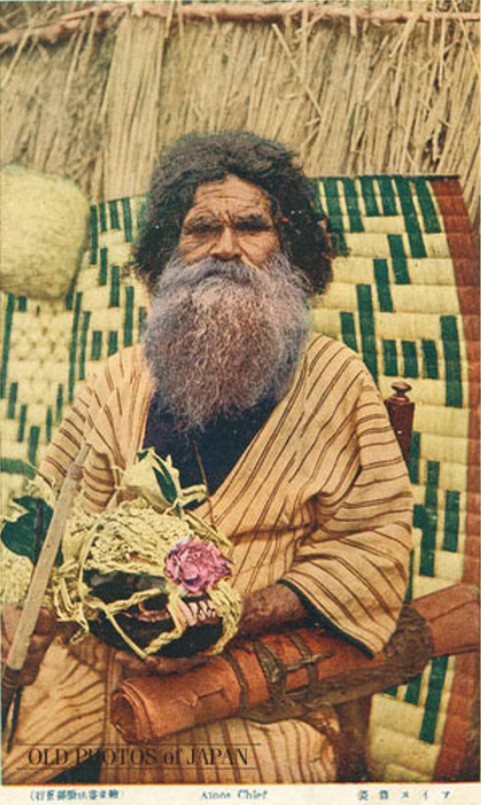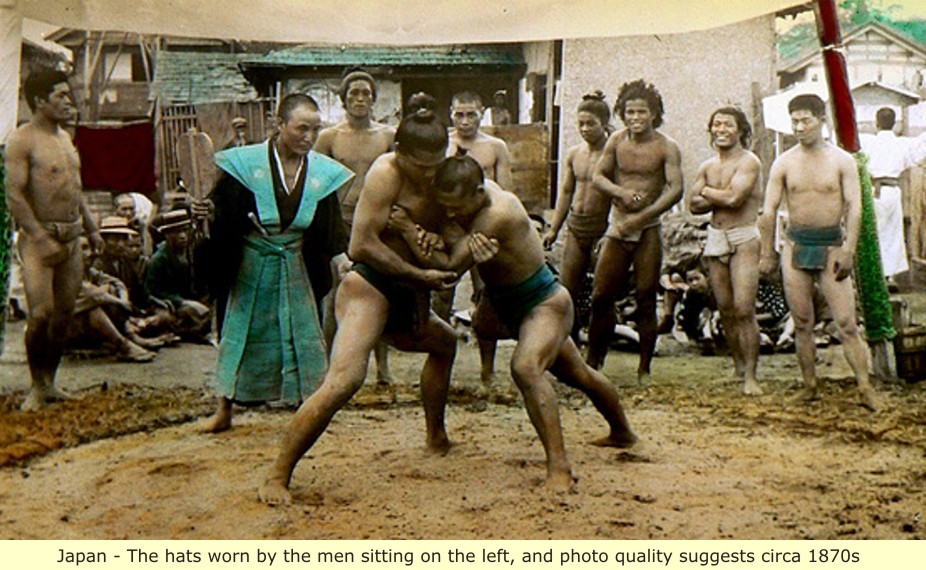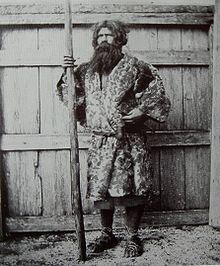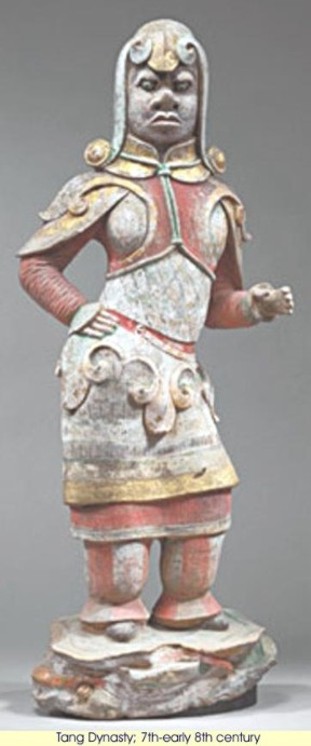lighten up jahahahaa*
Dude sounds hurt as fukk lmfao.
lighten up jahahahaa*
Im talking about this one:Which picture? This one?

This is an Ainu, again, not ancestors or direct relatives of the Yamato ethnicity which is the modern Japanese. Secondly, genetics and appearance are not the simple. Albinoism is simply lack of pigment where as many of the traits that we consider to define an ethinicity extend beyond just the color of one's skin. Also, I'm sure the frizzy hair trait in other races can be traced back to the fact we all come from Africa but again...I get the feeling this is being presented of recent evidence instead of the fact we all share a lot of the same genetic material that at time can pop up when it normally doesn't. There are "pure asian" folks with frizzy hair and kinky hair. Doesn't mean their grand dad was black, just they had the genetic trait that happened to appear during their birth that a lot of people might have that will never express.
Tbh, I don't even think we're disagreeing as far as the base issue here which is that all people can trace their ancestry to Africa if you go back far enough. Not debating that but, again the links and videos that are posted at times are disingenuous and contains a lot of cherry picking to support a narrative that has no other scientific or historical support. Like posting picture of black ceramic statues being evidence that these are pure africans instead of maybe a stylized choice of material.

Dude sounds hurt as fukk lmfao.


I'll take your word for t breh. I'm not familiar with the haplogroupings and things of that nature. I'm more familiar with the history. However I believe I've seen haplogrouping type of data that showed most East Asians share a lot of genetic similarities So I'm a bit skeptical that at least as it relates ethnicity that there is more in common with Africans than between a Chinese and Japanese. Can you educate me further as to what y-Dna is and whether this is a term to highlight a single genetic trait or a more broad label.
YASUKE: THE AFRICAN SAMURAI
Japan is not a place one would usually associate with immigrants from Africa or the Caribbean. Yet in the late 16th century Japan’s most powerful warlord, Oda Nobunaga, had a black page who was not only a cultural curiosity but also served as Nobunaga’s bodyguard and was granted the prestigious rank of Samurai.
This was a time of incessant warfare as the Ashikaga Shogunate fell and Japan became a war-torn nation with each tribe vying for control of against rival warlords. During this time the key to supremacy lay in controlling the powerless Emperor in his court in Kyoto. In the mid 16th century this civil war was nearing its end with the arrival of the Europeans and their modern armaments, guns and cannons. With these new weapons Japan would be reunified by three warlords: Oda Nobunaga would begin the process; his successor Toyotomi Hideyoshi would complete unification and Tokugawa Ieyasu would consolidate it an bring in an unprecedented 250 years of peace.
Nobunaga is himself a very interesting character. Nobunaga began life as a rather minor provincial lord until he defeated a one of Japan’s most powerful warlords of the time, Imagawa Yoshimoto, at the battle of Okehazuma (1560). Within the next 20 years Nobunaga had conquered nearly a third of Japan. Nobunaga was not only a powerful warlord but a master of strategy who pioneered the use of guns in battle. At the Battle of Nagashino, in 1575, Nobunaga managed to compensate the slow reloading time of the arquebus (an early musket) by organising his gunmen in lines of three; when one line fired the rows behind would fire giving time for the first row to reload again and so on. It is argued that Nagashino was the first “modern” battle because of Nobunaga’s ingenuity.
Nobunaga was obsessed with all things Western besides their armour and armaments and is one of the first recorded Japanese men to have worn Western clothing, use tables and chairs, and drink wine from goblets. Although it is a well known fact that Nobunaga was an atheist, his affinity with Western ways and the subsequent presence of the Jesuit missionaries in his court provoked rumours that he had converted Christianity, a label that has generally stuck in popular culture (this image of belonging to a foreign religion complements his reputation as one of the bloodiest warlords in Japanese history). However, his curiosity in the Jesuit missionaries was piqued by a black slave from Mozambique (some sources say Congo) who was the page of the Italian Visitor (inspector) of the Jesuit missions in the East, Alessandro Valignano.
We do not know this slave’s actual name but the Japanese called him Yasuke (彌介), the reason for this name is unknown as it does not have a clear meaning and that it is most likely a “Japanization” of his actual name. He was apparently 6ft 2in and would have towered over the Japanese of the day. Nobunaga first heard of Yasuke when the news reached him in 1581 of the great crush that had occurred when Valignano had brought him to Kyoto where his skin colour and height attracted a huge crowd. Nobunaga ordered the Jesuit to bring Yasuke to his court so that he could see this sensation in the flesh. Upon seeing Yasuke Nobunaga allegedly ordered his stripped to the waist and scrubbed believing that his skin was painted. Japanese sources described Yasuke as “looking between the age of 24 or 25, black like an ox, healthy and good looking, and possessing the strength of 10 men.
Nobunaga was further intrigued by the fact that Yasuke could speak Japanese (albeit not perfectly) and ordered Valignano to leave Yasuke in his care when the Jesuit prepared to leave again. Yasuke became a permanent fixture in Nobunaga’s retinue, his size and strength acting as a deterrent to assassination not to mention a flavour of exoticism to accompany the warlord’s other Western possessions. Apparently Nobunaga became so fond of Yasuke that rumours abounded that the slave was going to be made a Daimyo (a Japanese land-owning lord). These rumours were proven wrong, however, Yasuke was given the honour of being made a member of the samurai class, a rare honour among foreigners.
However, a year after Yasuke’s arrival in Nobunaga’s court, disaster struck. In June 1582 Nobunaga was betrayed by one of his closest generals, Akechi Mitsuhide. Akechi’s betrayal is still the subject of debate but it is likely that he acted out of the fear that Nobunaga was going to give his (Akechi’s) lands to Mori Ranmaru, with whom Nobunaga was engaged in a ritual homosexual relationship (common among the samurai classes and part of system of patronage). Nobunaga and his small retinue, including Yasuke, were besieged in Honno-Ji temple in Kyoto by Akechi’s army. Whilst the temple burned Nobunaga committed ritual suicide. Yasuke managed to fight his way out and fled to the nearby Azuchi castle with Nobunaga’s eldest son, Oda Nobutada. With Nobunaga out of the way Akechi attacked the castle and Yasuke is reported to have personally committed himself to the fighting. However, the defenders were soon overwhelmed. Yasuke survived the battle but, rather than commit suicide (the samurai tradition when facing defeat) he handed his sword to Akechi’s men (the Western tradition). Unsure of how to proceed the soldiers deferred to their lord. Akechi proved somewhat more bigoted than Nobunaga when he replied that Yasuke was merely a beast and not true samurai and, therefore, could not be expected to know the honour of seppuku (ritual suicide). Akechi handed Yasuke back to the Jesuits in Kyoto who were reportedly relieved to see him still in one piece.
It is unknown what became of Yasuke thereafter but in the space of a year this slave from far away Africa had been elevated to the Japanese warrior class, an almost unique occurrence in history, and had been involved in an event that changed the course of Japanese history. Despite this we know almost nothing about him although in Japan he has not gone totally unnoticed, he became the subject of a children’s historical fiction called Kuro-suke (くろ助).
Akechi Mitsuhide would be dead eleven days after his betrayal and another of Nobunaga’s generals, Toyotomi Hideyoshi, would go on to unify Japan. Hideyoshi’s own death would plunge Japan into civil war yet again and it would be Tokugawa Ieyasu (a former ally of Nobunaga and Hideyoshi) who would establish a dynasty that would last 250 years. Tokugawa would also expel all westerners (with the exception of a small Dutch enclave at Dejima in Nagasaki) and Christianity would be outlawed until the 19th century.
A small side note: Nobunaga’s line survived into the modern era. His 17th direct descendant, Oda Nobunari is a world champion figure skater (a strange twist given Nobunaga’s bloody reputation




Whites and Mongols are NOT Races!
The corollary to the above proofs and exhibits, is that the White mans division of the worlds people into the three Human races (Black, White and Mongol) is false and self-serving. When a group member of a species with a great variety of physical attributes - such as Black Humans - who exhibit ALL Human attributes: Black skin, White skin (Albinos), Broad noses, Narrow noses, Full lips, Thin lips, Wooly hair, Straight hair, Hair of all colors, Hair of all textures, Very tall people, Very short people, People with Mongol features - breaks away, and forms a "Supergroup" of ONLY those with a "Single" particular distinct attribute, and through some type of isolation - forced or otherwise, breed exclusively among themselves, thus producing offspring with only that one attribute. They create a Sub-species containing ONLY that attribute!
So when isolate members of a species ALL share a common trait, such as (White Skin - Albinism). They do not form a "New" Race, they form a SUB-SPECIES. Thus Whites are NOT a RACE, they are a SUB-SPECIES!
So when isolate members of a species ALL share a common trait, such as (Mongol features). They form a SUB-SPECIES. Thus Mongol is NOT a RACE, it is a SUB-SPECIES!
So when isolate members of a species ALL share a common trait, such as (extreme small stature - Pygmy) . They form a SUB-SPECIES. Thus the Pygmy is NOT a RACE, it is a SUB-SPECIES!
Therefore, there is only ONE RACE - the "All Encompassing" Black skinned Human race: all others are Sub-species.
I know nigerians called haruna.By the way, these are not nigerian names
. Some of them may be but Watanabe, Edo(ancient name of tokyo btw), Haruna, for example are purely japanese names.